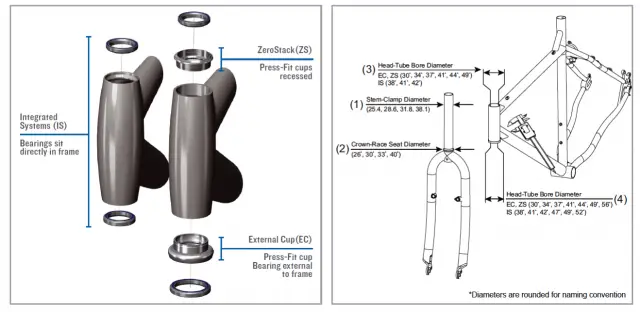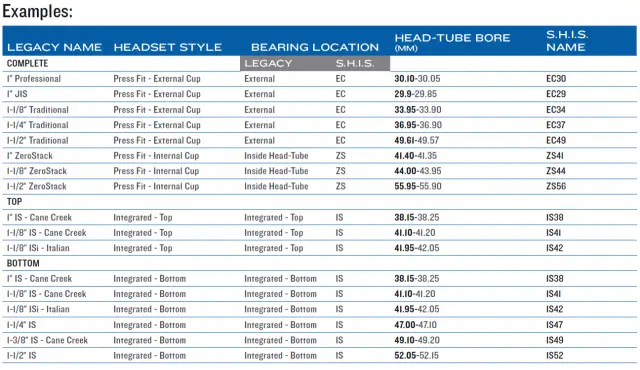We’ll be honest here, we’ve struggled to get our heads round a lot of the new headset ‘standards’ that have emerged in the last couple of years, especially since tapered heatubes became de-rigeur. It hasn’t helped that manufacturers have used various names for each of the standards. In a rare moment of inter-industry talking and acting it looks like things might get a little simpler. Here’s what we received from Cane Creek this morning…

Headset Manufacturers Partner in Development of Fitment System
November 9, 2010 – To address the changing landscape of bicycle headsets, a group of leading headset manufacturers have collaborated to develop a standardized “language” for headset fitment. The new Standardized Headset Identification System (S.H.I.S.) creates a common language for describing modern bicycle headsets. The system provides comprehensive and scalable headset fitment information in a standard format; making it easier to communicate headset requirements based on frame and fork interfaces.
“As a bicycle manufacturer I have participated in many conversations with customers who are struggling to understand modern headset fitment,” says Michael Bonney of Orange Mountain Bikes. “During Eurobike and Interbike I suggested to a couple of headset makers that a universal system for talking about headsets was needed, and I’m excited to see it happening.”
The Standardized Headset Identification System (S.H.I.S.) incorporates the four critical interface dimensions required to fit a fork to a frame, as well as explicitly noting bearing location/cup type.
The group of companies leading the development of the new headset naming system include: Acros, Cane Creek, Hope, Race Face, Reset and Ritchey. Each of the participants has committed to integrate the Standardized Headset Identification System into their respective businesses over the course of the next year and encourage additional headset manufacturers to follow. Select bicycle parts distributors will have partial integration of the S.H.I.S. in their 2011 catalogs with further inclusion throughout the year. On the bicycle manufacturing level, several early adopters will begin using the system on their new model-year bikes.
“Headset standards were getting a bit out of control and the nomenclature to keep it all together was unraveling,” says Steve Domahidy, co-owner of Niner Bikes. “It was becoming difficult to talk to customers about headsets and help them understand, so this system takes out the guesswork and makes it as easy as it can be to insure that everybody’s speaking the same language.”

To learn more about system methodology and to view specific examples and illustrations, please download the complete S.H.I.S. overview. Or contact one of the participating headset manufacturers listed above. A collaborative website, BicycleHeadsets.com, is under development and will explain in detail the Standardized Headset Identification System complete with examples and drawings. BicyleHeadsets.com will be available by the end of November.

Comments (21)
Leave Reply
Post Comment

“Standardized Headset Identification System (S.H.I.S.)”
Couldn’t it be a Standardized Headset Identification Tag……..
I’ll get my coat
Standard Headset Identification Zone
“It’s da SHIZ”
I’ve read it. I don’t get it.
So now I need to know the type of headset required, the bore of the tube it’s going into and the diameter of the stem & the crown race seat………..??
Does this cope with tapered head tubes fitted with standard steerers??
You’ve always needed to know that though surely?
This is just a uniform way of naming headsets so once you know which one you need you can just look up that code with each supplier.
Headset sizes quoted in imperial then tube bores & seat diameters quoted in metric, Genius!
Would it have not been clearer still to indentify top and bottom races in the coding. Say Z for headset type the U and L for upper/lower races?
thus ZU 44/28.6 : ZU 44/30
It’s all got a bit silly really.
Some one needs to get the manufacturers together. Make them a nice cup of tea with a couple of bourbons, and tell them it’s high time they stopped squabbling and just learnt to share one standard like proper adults.
is the frame in the little diagram correctly aligned?
Looks twisted at the seattube
I’m sure there’ll be another classification system along next week anyway, if you don’t like this one.
I like what they’re trying to do, it’s just a shame they’ve still not resolved the issue of how deep to make the bottom bore on the IS headsets. Some are 7mm, others are 9.5mm.
I urge everyone to vote with their wallets and buy bikes/frames is simple 1 1/8″ HT.
The all this horror will quickly fade away.
And when the funk are we going to arrive at a time when bike manufacturers realise that it makes so much more sense to use the metric system to measure things?
is it April 1st already?
Will anyone else other than cane creek adopt this system?
I think “Standardized Headset Identification Thema” would have been much more appropriate mikewsmith:
“Thema” –noun
1. a subject of discourse, discussion, meditation, or composition; topic.
2. a unifying or dominant idea, motif, etc.
–adjective
1. having a unifying theme.
They’ve missed an important grammatical opportunity there I think…
I’m not sure if the tears in my eyes are from laughing or crying.
nothing to tell you how tall the headset is though.
i would have tagged on another number when putting the code together.
or we could all just MTFU and use Pig Pros like god intended
I’d like to be the first person to leave a positive comment on this story…
But no.
For most people, “evolving” (made-up on the back of a napkin in order to sell un-necessary proprietary crap) headset “standards” bring very little benefit and lots of hassle. Don’t even get me started on bottom bracket “standards”.
BMX has a small number of HS and BB standards that take far more abuse than most middle-aged MTBers can dish out. It’s a pity the industry didn’t adopt those.
Golden rule:
If you want to be able to find replacement parts for a bicycle in 20 years (even 18 months?), support companies that support you, rather than those who will leave you up s**t creek (should that be “up Cane Creek”?) without a paddle.
I have cranks, BB, HS, HS adapter, hubs etc by Profile BMX, Phil Wood, Chris King etc. that will last me years. And which they will still support when I eventually need spares. Rather than scrapping a frame or fork for lack of support / compatibility.
Genuine innovation? Yes – All for it.
But buy into questionable designs and marketing tosh at your peril.
For all the negative comments, it’s pretty obvious from this/other forums that a lot of people really *can’t* work out what different headset types are, so I can understand why this has come about. IMO, between the Chris King and Cane Creek websites
(eg http://canecreek.com/manuals/Headset%20Tech%20Specs%20Rev%20E.pdf)
there’s enough info to work it out, but it seems to be too much of a challenge for some people. Plus tapered headtubes are gonna add to the confusion.
>Headset sizes quoted in imperial then tube bores & seat diameters quoted in metric.
Because that’s how they’re *currently* described/measured.
>makes so much more sense to use the metric system to measure things?
The imperial description is how they’ve been known up to now (with some anomalies eg crown race dia). The reference just bundles the imperial description/metric measure for the hard-of-understanding! Now I don’t have a problem with metric, but referring to 1 1/8 headsets as “28.575mm” is still gonna confuse some people…
>use Pig Pros like god intended
IME the **** things seem to be oversized !
Upper/lower reference – unneccessary, it’s inferred by context – just ask you don’t need to describe socks as being for your hands or feet.
Looks like it also tries to clarify crown race diameter, which is no bad thing, if you look at the actual document.
@onzadog
>I like what they’re trying to do, it’s just a shame they’ve still not resolved the issue of how deep to make the bottom bore on the IS headsets. Some are 7mm, others are 9.5mm.
Good point – looking at the Cane Creek website, there’s also the Italian version at 6.8mm – but couldn’t see any reference to 9.5mm – who uses that ? Equally it doesn’t mentioned tolerances (tho’ it is in the document link I gave), but most people aren’t going to care unless the cup’s a sloppy fit in the headtube.
Will FSA sign up to this?
Having bought a frame with a 1.5″ headtube and a tapered steerer fork, I’m all for anything that would have made it easier for me to buy a headset to fit. I still would have bought the FSA BIg Pig tho’ 🙂